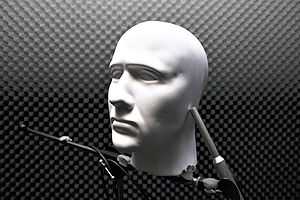Dummy head recording

 |
|
| Problems playing this file? See media help. | |
 |
"One Man Rumba" binaural musical demonstration
A binaural recording. The desired effect can be achieved only with stereo headphones. |
| Problems playing this file? See media help. | |
In acoustics, dummy head recording (also known as artificial head or Kunstkopf) is a method used to make binaural recordings that allows a listener wearing headphones to perceive the directionality and the room acoustics of single or multiple sources.
Human perception of the direction of a sound source is complex, and consists of:
- Simple "left-right" information can be gained from relative level differences and time of arrival differences of the sound in each ear.
- For percussive sounds, the impact of a shock wave can register perceptibly on the skin (typically the upper torso), with the earliest and strongest sensory stimulus coming from the regions of skin aligned perpendicular to the direction of the sound source.
- The human head imprints frequency-dependent distortions of phase and amplitude on sound reaching the eardrums, that are frequency-dependent level differences and these distortion effects vary with the direction of the sound source (being caused by the geometry and sound-transmitting characteristics of the sinus and throat cavities, eustachian tubes, inner ear, external ears, and other hard and soft tissues in the head and upper body (see: head-related transfer function, "HRTF").
Conventional stereo recording only makes use of left-right information. Dummy head recording uses both left-right information and frequency-dependent distortions.
Methods
There are two main ways of making a recording that uses this last effect to encode directionality information:
- Dummy head recording uses an artificial model of a human head, built from selected acoustic materials to emulate the sound-transmitting characteristics of a real human head, with two microphone inserts embedded at the "eardrum" locations.
- Simulated dummy head recording processes a signal electronically to imprint the HRTF information associated with a specified direction.
Limitations
Because each person's pinnae are unique, and because the filtering they impose on sound directionality is learned by each person from early childhood, the use of pinnae during recording that are not the same as the ultimate listener may lead to perceptual confusion.[1]
History
Historically, dummy head recordings have been associated with the use of a physical synthetic head, the "Kunstkopf". The "head" could be placed in a concert hall to make a live orchestral recording, or actors could stand around the head when recording their dialogue. The head could also be used to imprint positional information on prerecorded sound effects by playing sounds through a loudspeaker placed in a suitable position by the head, and rerecording the result (for instance, it might be desirable for birdsong or thunder to seem to be coming from above the listener; this would not be achievable using conventional methods).
Demolition was the first radio drama recorded using a dummy head.[2]
In 1974 Virgin Records issued the first solo album by Tangerine Dream's leader Edgar Froese, titled Aqua. The brief sleeve notes inform listeners that side 2 of the disc - i.e. the tracks NGC 891 and Upland - were recorded using the artificial head system developed by Gunther Brunschen. Listeners were advised to optimise their listening by using stereo headphones for that side of the album.
Although Edgar was keen to continue to use and promote this system for subsequent recordings, it was abandoned, due to the fact that, although it worked well through headphones, the improved sound quality did not translate adequately through a hi-fi speaker system.
In 2005, Aqua was remixed for limited edition reissue in Germany and Japan, with an additional track Upland Dawn appended to the end of the CD.
In the 1990s, electronic devices were made commercially available that used DSP processing power to reproduce an HRTF digitally. These devices allowed the operator to use dials to adjust the apparent direction of sounds in real time. They were unusual and expensive, but allowed an operator to "position" pre-recorded special effects quickly and conveniently, and also to move sound sources dynamically. By manipulating the dials, the sound engineer could take a monophonic recording of a passing car and make it sound to the listener as if it were passing behind them in a particular direction. With a "physical" dummy head, this would have also required a rerecording booth, and either a single moving loudspeaker or an array of speakers and some sort of multiple panning or switching device.
See also
References
- ↑ Wenzel EM, Arruda M, Kistler DJ, Wightman FL. Localization using nonindividualized head-related transfer functions. J Acoust Soc Am 1993;94(1):111–23
- ↑ Bülow, Ralf (31 August 2013). "Vor 40 Jahren: Ein Kunstkopf für binaurale Stereophonie". Heise News (in German). Hannover: Heinz Heise. Retrieved 27 July 2014.